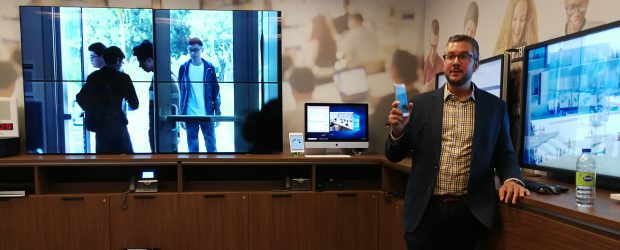
From WiFi technology that can collect student behaviour patterns to security cameras that keep schools safe, Cisco’s latest installment of the Education Room in its Innovation Centre focuses on the possibilities of emerging technology that can be used in universities and colleges.
During an interview at the Cisco Canada office in downtown Toronto, Wayne Cuervo, director of innovation at Cisco, said the Education Room is the latest iteration of the Innovation Centre that was established about two years ago.
Previous rooms showcased Cisco’s partners working on emerging technology in various spaces including healthcare, retail, and financial services.
“We try to take those technologies that are emerging and possible and help a customer see how technology can be used in the different ways to drive better outcomes, it’s not about the technology and we’re not pushing the technology for technology’s sake,” Cuervo said. “We are focusing on the business outcome, not for just the technology.”
The Education Room had a soft launch one month ago and on Sept. 26 media and analysts were invited to check out some of the latest technologies that schools could potentially use in the future.
Degree Analytics, one of Cisco’s partner companies, created student analytics, which, as Cuervo jokingly said, “may be a bit Big Brother-ish, because of the data that you can gather.”
This system would allow WiFi that is connected across the campus to provide an entirely new set of data that can be overlayed on historical patterns that have been collected for years such as students attending classes, how much time is spent in the library or social areas, how much time is being spent attending events on campus. That information could be used to determine a “risk factor” to a student’s performance.
Information collected can even be “drilled down to specific students,” Cuervo said.
For example, Ronald, a physics student, might need 80 per cent class time and 20 per cent on campus social events, but that information could be different for a political science student.
“WiFi analytics provides the opportunities to get that level of granularity for universities to understand how students are interacting with their space and with their learning experience,” Cuervo said. He added the type of information can be collected could include class attendance, GPA, and activity history.
Cuervo said that this type of technology is further being developed to understand mental health patterns. The idea behind it is to see student behaviours and any dips in those behaviours to sense mental health concerns.
Though Cuervo did indicate that all of this could be done on an anonymity basis, or students could opt in. Questions around privacy and security were also raised, and Cuervo noted that because these solutions are still being developed those concerns were raised to Cisco’s clients.
Cuervo explained that the technology showcased in the room are available today but implementing the technology can be challenging if universities don’t have specific policy systems or the physical infrastructure.
“Do they have Cisco’s WiFi? If they don’t they’re not likely to have the analytics engine from a competitor that these partners can plug into or can get the data from,” Cuervo said, adding that Cisco provides the wireless connection, the WiFi system, that a campus would use to deploy the technology.
Another education partner that deals specifically on security systems was also featured in the Education Room.
Iomniscient created a system that turns WiFi into sensors that inform building management systems with real-time occupancy. This could work well in universities to indicate if people are registered to the school and have access, thus being able to detect any anomalies or strangers. Though again the question of privacy was brought up and Cuervo said that many people might be against a school having access to photos or personal details.
John Zhang, a research analyst at IDC Canada, said that these innovations are completely possible and they are “demonstrations of what kind of digital transformation” and direction campuses are heading in.
“A lot of the technology is not readily available but it demonstrates what the capabilities are in the near future,” Zhang said. “It also raises concerns on privacy and on controversial issues especially on campuses…[but] they’re realistic and these can be implemented across campuses.”
Zhang did note that right now the trajectory that schools are taking are more towards understanding and learning how to digitally transform.
“Whether it’s remote access or online learning platforms, or online classes, that’s certainly where the education industry is heading towards,” he said.